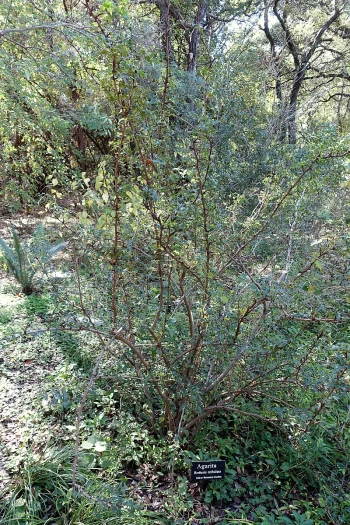Desert Holly
(Mahonia trifolia)
Desert Holly (Mahonia trifolia)
/
/

Daderot
CC0
Image By:
Daderot
Recorded By:
Copyright:
CC0
Copyright Notice:
Photo by: Daderot | License Type: CC0 | License URL: https://creativecommons.org/licenses/by-sa/3.0 | Uploader: Daderot | Publisher: Wikimedia Commons |

Estimated Native Range
Climate Requirements for Valdosta, Georgia
| This Plant | Your Site | Plant Suitability for Your Location | ||
|---|---|---|---|---|
| • Precipitation | 12" - 66" | 49" | Aquatic | Aquatic |
| • High Temp. | 58°F - 95°F | 92°F | Your summer temperatures are normal for this plant. | Excellent |
| • Low Temp. | 23°F - 57°F | 40°F | Your winter temperatures are normal for this plant | Excellent |
This plant may not grow well at your location - your precipitation is too high.
Summary
Mahonia trifolia, commonly known as Desert Holly or Agarita, is an evergreen shrub native to the chaparral, scrublands, and rocky hillsides of Texas, New Mexico, and Mexico. It typically grows to a height of 3-8 feet (0.9-2.4 meters) and a width of 3-5 feet (0.9-1.5 meters), with a dense, rounded form. The plant is characterized by its holly-like, trifoliate, leathery leaves that are blue-green with a waxy coating and sharp spines on the margins. In late winter to early spring, before the emergence of new leaves, it produces fragrant, bright yellow flowers that are quite showy, followed by red, edible berries that are favored by birds and can be used to make jelly.
Desert Holly is valued for its drought tolerance, low maintenance requirements, and the ornamental qualities of its flowers and berries. It is often used in xeriscaping, as a barrier plant due to its spiny leaves, and in wildlife gardens to attract birds. It thrives in full sun to part shade and is adaptable to a range of soil types, provided they have good drainage. While it is generally disease-resistant, overwatering can lead to root rot. It is also important to note that the plant’s spines can make it difficult to handle, so it should be placed carefully in the landscape.CC BY-SA 4.0
Desert Holly is valued for its drought tolerance, low maintenance requirements, and the ornamental qualities of its flowers and berries. It is often used in xeriscaping, as a barrier plant due to its spiny leaves, and in wildlife gardens to attract birds. It thrives in full sun to part shade and is adaptable to a range of soil types, provided they have good drainage. While it is generally disease-resistant, overwatering can lead to root rot. It is also important to note that the plant’s spines can make it difficult to handle, so it should be placed carefully in the landscape.CC BY-SA 4.0
Plant Description
- Plant Type: Shrub
- Height: 3-8 feet
- Width: 3-5 feet
- Growth Rate: Moderate
- Flower Color: Yellow
- Flowering Season: Spring, Summer
- Leaf Retention: Evergreen
Growth Requirements
- Sun: Full Sun, Part Shade
- Water: Low
- Drainage: Medium, Fast
Common Uses
Bee Garden, Bird Garden, Border Plant, Butterfly Garden, Deer Resistant, Fragrant, Hummingbird Garden, Low Maintenance, Rabbit Resistant, Showy Flowers
Natural Habitat
native to the chaparral, scrublands, and rocky hillsides of Texas, New Mexico, and Mexico
Other Names
Common Names: Paisano Bush, Una De Gato, Chichilcuahuit, Algerita
Scientific Names: Berberis trifolia, Mahonia trifoliata, Mahonia trifolia, Berberis schiedeana, Berberis ilicina, Mahonia ilicina, Mahonia schiedeana, Odostemon trifolius, Berberis roemeriana
GBIF Accepted Name: Mahonia trifolia Cham. & Schltdl.